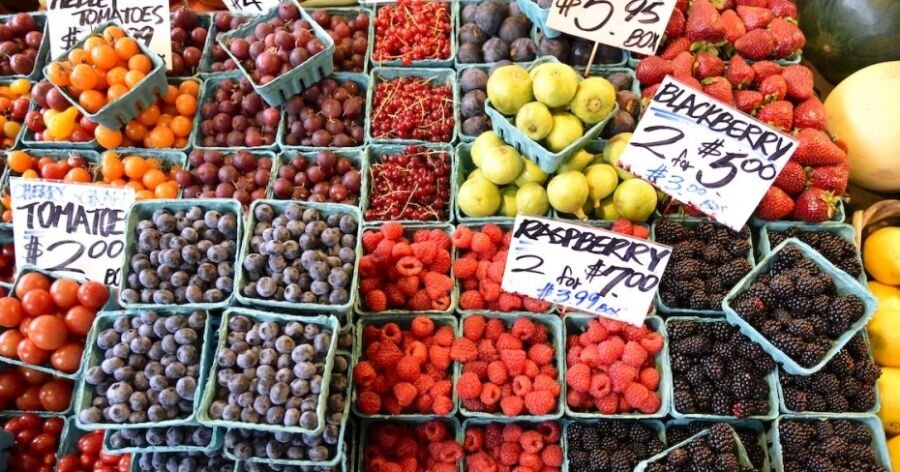The Ontario Food Terminal helps keep produce prices low. But it might close
By: Lisa Coxon on June 28, 2019
Update: On July 8, 2019, the province announced that the Ontario Food Terminal will not be moving from its current location in Etobicoke. Agriculture Minister Ernie Hardeman said there are plans to modernize and update the terminal with better technology and equipment.
Imagine it’s the weekend and you’re headed out for groceries.
You could do your entire shop at a Loblaws or a Sobeys, but there happens to be a fruit and vegetable market in your neighbourhood that sells fresh and beautiful produce for a better price. You prefer to buy the produce you need from here instead, to save some money and get your hands on Ontario-grown fruits and vegetables — ones that didn’t have to travel all the way from Mexico or California.
The above-scenario is possible because of the Ontario Food Terminal.
Established in 1954 and located in Etobicoke, the terminal is where Ontario farmers, wholesalers, and independent grocers come to buy and sell fruits and vegetables. Around 5.6 million pounds of produce, on average, makes its way through the terminal every single day, which amounts to more than $3 billion every year.
It’s the only place where independent retailers can compete on price with bigger businesses, who generally have alternate supply chains that are inaccessible to the “little guys.” This has a direct effect on our grocery and restaurant bills.
But the food terminal’s existence is under fire. In its April budget, the provincial government said it’s reviewing the future of the terminal. Some fear it could be closed down or broken up into smaller regional centres. There’ve even been murmurs that the highly valuable 40 acres of land the terminal sits on could be sold to developers for condos.
Local farmers and independent grocers are, understandably, concerned about what this would do to their business. And consumers should be worried about what it will do to their finances.
Shuttering the food terminal will cost us, too. Here’s how:
Fewer greengrocers; maybe none at all
Toronto’s abundance of independent fruit and vegetable markets provide so many of the city’s neighbourhoods with affordable and fresh produce. At these places, you can usually find a head of kale or a bunch of apples for a cheaper price than you would at the bigger grocery store chains — especially when the produce is in season. That’s because the owners of these markets go directly to the terminal for their selection of produce, too.
The terminal is also a great place for these businesses to buy plants and flowers. The woman who owns the store on the corner of my street gets to the terminal as early as 2 a.m. some days in order to get the best pick of things like fiddle leaf fig trees, succulents, hanging baskets and mandevillas for her store.
If the terminal were to close, she told me, she wouldn’t be able to afford the high costs of a supplier — or a longer commute. (She already drives 30 minutes to get to the terminal in the mornings.) Plus, the selection of plants and flowers these suppliers provide is very limited, she said, whereas the terminal offers a wide variety. If the terminal closes, there’d be no plants or flowers at her store anymore. She said it would “totally destroy” Toronto’s convenience stores and bodegas who stock produce, plants, and flowers that they buy from the terminal.
If independent grocers have nowhere to buy their produce from, big chains like Loblaw and Metro would have a tighter grip on the flow of produce to consumers
Independently owned grocery stores which buy direct from the terminal would also suffer. Places like Fiesta Farms, for instance, located at Bloor and Christie, would likely have a hard time continuing to operate at the prices they do when produce is in season. As would places like Longo’s, which buys about 70% of its produce direct from the terminal.
And if independent grocers have nowhere to buy their produce from, big chains like Loblaw and Metro would have a tighter grip on the flow of produce to consumers, as they have preallocated and pre-purchased their produce through a different supply chain than the terminal. This could also cause price hikes.
That’s not to say there aren’t other factors already making produce more expensive, like the rise in inflation, which sent the price of fresh vegetables soaring by almost 17% year-over-year in May. But there is a chance that the terminal’s closure could give big-box grocery stores the opportunity to raise their produce costs even more.
“If you didn’t have it consolidated, you wouldn’t have the same level of competition, and prices would go up,” Mike Longo, vice president of Longos told the Toronto Star in April. “That would definitely have an impact on the consumer.”
Higher restaurant bills
Closing or breaking up the food terminal won’t have much of an affect on the big chain restaurants, but there’s a good chance it will disrupt what you see on the menus of some smaller, independent restaurants.
Any restaurants that buy direct from the terminal are able to keep their food costs lower and, as a result, their menu prices relatively low because they’re not having to pay a fee to a supplier.
My partner is the head chef of one such restaurant in Toronto’s Little Italy neighbourhood. Each week, he makes two trips to the food terminal. Any restaurant that’s not a big box chain, he says, would incur a serious hike in cost of goods.
If the food terminal were to close, the wholesalers that supply these smaller restaurants would effectively disappear, as would the opportunity for these restaurants to buy direct from farmers. Because they’d now need to buy through a different supply chain, from behemoth wholesale companies like Sysco Canada and Gordon Food Service, it’s likely that these restaurants would have to increase the prices on their menus.
What does the future hold?
My partner signed an online petition aimed at protecting the future of the terminal a couple of months ago.
In May, he got an email from our Minister of Agriculture, Food and Rural Affairs, Ernie Hardeman, explaining that the province was putting together an advisory group of people from the agri-food, agri-business and agriculture sector as well as commissioned a third-party report to determine the fate of the terminal.
“This government recognizes the Ontario Food Terminal is an important part of the success of Ontario’s agri-food industry and we will make sure it continues to play a key role,” the email reads.
“It provides a market to get the best produce in the world to Ontario families and businesses, and it will continue to do so.”
Let’s hope. Because without it, we could see many independent grocers — and their competitive prices — disappear.


